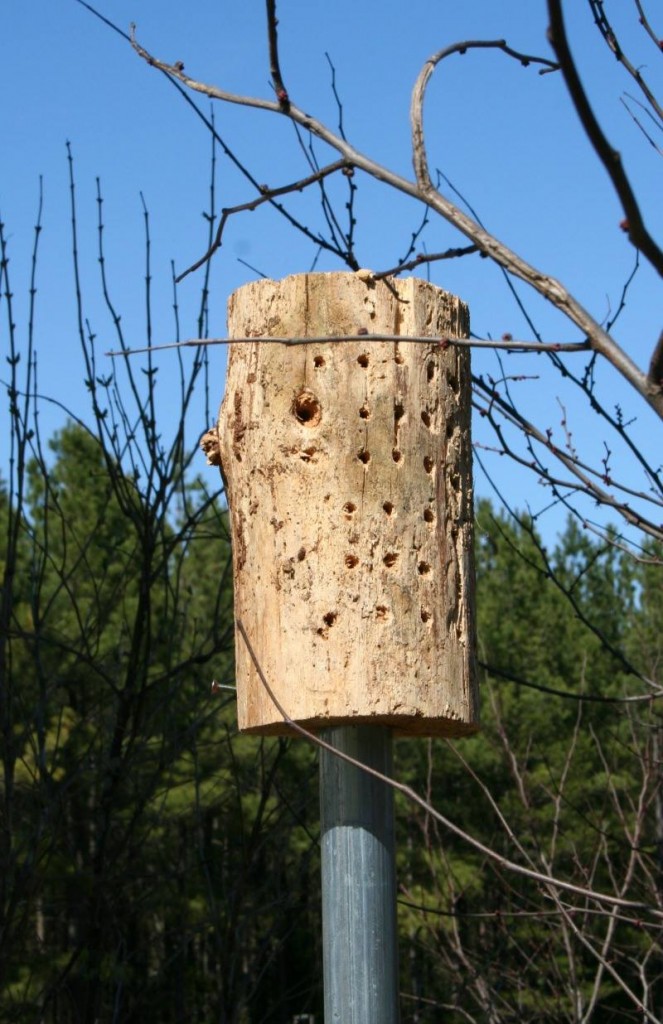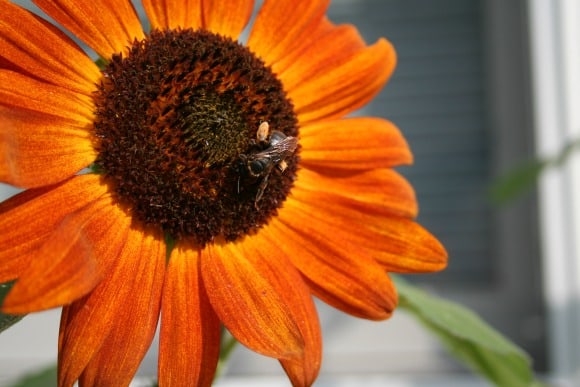It might look like a big old wine cork on a metal stick, but this is our attempt at building a mason bee house.
When people talk about saving the bees, they’re usually speaking of honey bees. Honey bees aren’t native to the United States. Like most of us, they’re immigrants. They came along with the Italian and other European immigrants who wanted the delicious honey they provided, along with their wonderful abilities to pollinate orchard flowers. According to the Almond Board of California, 1.6 million honey bee hives are needed annually to pollinate the state’s almond crop. That’s a lot of bees!
Worldwide, however, bee keepers struggle with colony collapse disease, fungal and other infections, and mites, insects and even wild animals such as bears who break into the hives to steal the honey. Our neighbors lost their honey bees to insects; we’ve heard of other local beekeepers losing hives, too. So while we wanted to add beehives to the farm this year, I wasn’t keen on the idea of investing $500 or more in bees and equipment, not to mention the steep learning curve of caring for bees and harvesting their honey. There had to be a better way.
Enter the Orchard Mason Bee. This little guy is Virginia’s native pollinator, and in fact, native to the United States. They’re solitary nesters, which means that unlike honey bees who congregate in a hive, the Orchard Mason Bee lays her eggs inside a single chamber in a hollow log or other suitable place. Each queen bee finds a hole about five or six inches deep, and about 5/16th of an inch wide – about the size of a hole drilled by a woodpecker’s bill. She lays a female egg in the deepest recesses of the chamber, transports lovely nectar-rich food to the egg chamber, then uses mud to wall the new queen egg inside. She then lays male eggs in the outer portion. Each bee nests alone, and does not produce honey, but because Mason Orchard Bees are covered entirely with hair, pollen sticks all over their bodies. Unlike the lovely honey bee, who carries her pollen neatly in two little sacs, Mason Bees are messy bees – and they wriggle their little bee selves around in happiness when they find new flowers, thus shaking off some pollen as they enter the flower. That makes them terrific pollinators!
If you want to help bees for food production and to increase the yield from your garden, the trick is to help the Mason Orchard Bees and other native pollinators. Sure, it’s a great idea to help honey bees; all bees need and deserve our protection. So stop using pesticides, or spray in the evening when bees aren’t active. Leave some dandelions, clover and other flowers for bees, and plant for three seasons – spring, summer and fall blossoms, so that the bees always have a food source available.
But if you really want to help boost the numbers of local pollinators, use these tips from the North Carolina Cooperative Extension and the National Wildlife Federation to build nesting sites for Mason Orchard Bees.
- Native Orchard Bees nest in blocks of untreated wood. A 4″ x 6″ wooden block is fine. We cut down an old pine tree that was already leaning over, and cut out a piece of truck about that size for our bee house.
- Smooth, 5/16″ of an inch holes are important. Anything bigger or smaller and you may not attract bees.
- Orchard Bees need mud puddles to wall up their eggs, so if you can, make a little mud for them nearby.
- Straws, bamboo and other similar structures, grouped together into a frame, also make a nice orchard bee house.
- You can buy orchard bee houses online, too.
- Grow flowers for early, middle and late spring and fall, too. These provide valuable and necessary food for Mason bees.
- Once your bee house is in place, leave it alone! Don’t move it until the winter. The bees are gentle, but they don’t like to be disturbed.
I hope that these tips will inspire you to try your hand at what I laughingly call “adult arts and crafts” and to make your very own orchard bee house. Whatever we can do to help bees thrive, we should do. Our food supply and our lives depend on these vigorous little creatures!







I had never heard of the mason bee. This is a really interesting read! Thanks for educating me on how to build a house for the mason bee and a few facts about honey bees I did not know.
I’ve never researched the kind of bees we have on our property but there is no shortage of them. We have not begun the spring yard chores yet because the bees are still doing their thing along with all of the pollen and neither of us can stay outside for long. We do have carpenter bees drilling nice size holes in our porch and on the deck as well, even though the lumber is treated. There is one bee in particular, very large, living on the deck off the kitchen and doing a great job of keeping me away.
I had to laugh I first thought it was a wine cork. This definitely was an interesting read. M going to share this with a friend who is a bee keeper
That’s pretty neat! I never thought to build a home for the bees…I’m normally running from them LOL